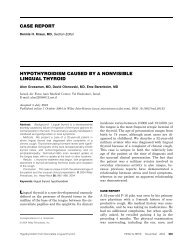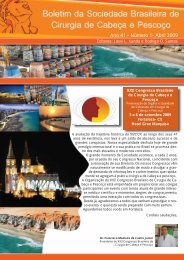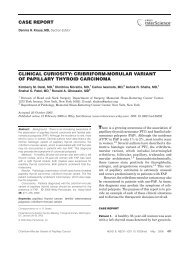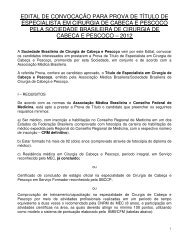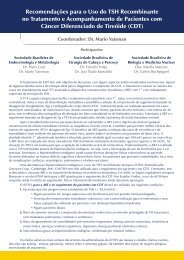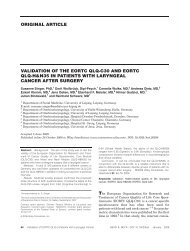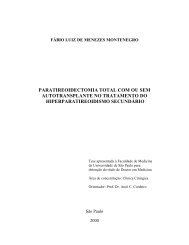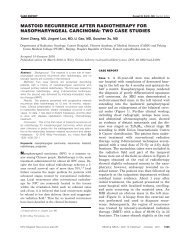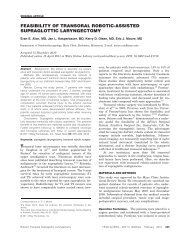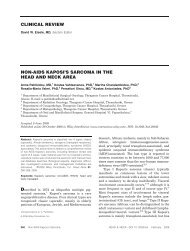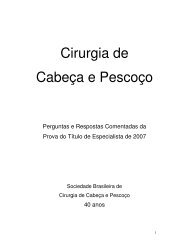Accuracy of fine-needle aspiration cytology of salivary gland lesions ...
Accuracy of fine-needle aspiration cytology of salivary gland lesions ...
Accuracy of fine-needle aspiration cytology of salivary gland lesions ...
Create successful ePaper yourself
Turn your PDF publications into a flip-book with our unique Google optimized e-Paper software.
ACCURACY OF FINE-NEEDLE ASPIRATION CYTOLOGY OF<br />
SALIVARY GLAND LESIONS IN THE NETHERLANDS<br />
CANCER INSTITUTE<br />
Rolf J. Postema, MD, 1 * Mari-Louise F. van Velthuysen, MD, PhD, 2<br />
Michiel W. M. van den Brekel, MD, PhD, 1,3 Alfons J. M. Balm, MD, PhD, 1,3<br />
Johannes L. Peterse, MD 2<br />
1 Department <strong>of</strong> Head & Neck Oncology, The Netherlands Cancer Institute—Antoni van Leeuwenhoek<br />
Hospital, Amsterdam, The Netherlands<br />
2 Department <strong>of</strong> Pathology, The Netherlands Cancer Institute—Antoni van Leeuwenhoek Hospital,<br />
Amsterdam, The Netherlands. E-mail: m.v.velthuysen@nki.nl<br />
3 Department <strong>of</strong> Otorhinolaryngology, Academic Medical Center, Amsterdam, The Netherlands<br />
Accepted 5 November 2003<br />
Published online 20 April 2004 in Wiley InterScience (www.interscience.wiley.com). DOI: 10.1002/hed.10393<br />
Abstract: Background. To evaluate the accuracy <strong>of</strong> <strong>fine</strong><strong>needle</strong><br />
<strong>aspiration</strong> <strong>cytology</strong> (FNAC) in <strong>salivary</strong> <strong>gland</strong> <strong>lesions</strong> in a<br />
tertiary referral center.<br />
Methods. A cytohistologic correlation study was performed<br />
using an automated pathology database <strong>of</strong> 1023 patients<br />
diagnosed with a <strong>salivary</strong> <strong>gland</strong> lesion.<br />
Results. In 388 cases, both <strong>cytology</strong> and histology were<br />
available. Using cytologic confirmation <strong>of</strong> malignancy as the<br />
starting point, the sensitivity, specificity, and accuracy <strong>of</strong> FNAC in<br />
this study were 88%, 99%, and 96%, respectively. Exact typespecific<br />
concordance <strong>of</strong> the malignant diagnosis was achieved in<br />
66 (88%) <strong>of</strong> 75 cases and in 211 (95%) <strong>of</strong> 223 benign cases. Of<br />
the 19 cases with a cytologic diagnosis ‘‘cyst,’’ four proved to be<br />
Correspondence to: M. L. F. van Velthuysen<br />
*Present address: Department <strong>of</strong> Otorhinolaryngology, Groningen University<br />
Hospital, P.O. Box 30.001, 9700 RB Groningen, The Netherlands.<br />
This study was presented as a poster at the fall meeting <strong>of</strong> the<br />
Netherlands Society <strong>of</strong> ORL and Cervic<strong>of</strong>acial Surgery in 2001,<br />
Amsterdam, The Netherlands.<br />
B 2004 Wiley Periodicals, Inc.<br />
malignant. A non-neoplastic lesion at <strong>cytology</strong> proved to be<br />
correctly classified in 53 (68%) <strong>of</strong> 80 patients.<br />
Conclusions. Our data show that <strong>cytology</strong> is a reliable and<br />
accurate technique to assess <strong>lesions</strong> <strong>of</strong> the <strong>salivary</strong> <strong>gland</strong>s. The<br />
cytologic diagnosis <strong>of</strong> ‘‘cysts’’ and ‘‘non-neoplastic <strong>lesions</strong>’’<br />
should be interpreted with caution. A 2004 Wiley Periodicals,<br />
Inc. Head Neck 26: 418–424, 2004<br />
Keywords: <strong>fine</strong>-<strong>needle</strong> <strong>aspiration</strong>; <strong>salivary</strong> <strong>gland</strong> <strong>lesions</strong>; cytologic<br />
diagnosis<br />
There is widespread acceptance <strong>of</strong> the importance<br />
<strong>of</strong> <strong>fine</strong>-<strong>needle</strong> <strong>aspiration</strong> <strong>cytology</strong> (FNAC) in<br />
the diagnosis <strong>of</strong> <strong>salivary</strong> <strong>gland</strong> <strong>lesions</strong>. 1–10 Nevertheless,<br />
the relative value <strong>of</strong> FNAC in distinguishing<br />
among the various types <strong>of</strong> malignancies<br />
and the assumed minor influence <strong>of</strong> FNAC on<br />
treatment planning are sometimes used as arguments<br />
against <strong>cytology</strong>. 11,12 In the literature, the<br />
diagnostic accuracy <strong>of</strong> FNAC ranges from 84%<br />
13 – 19<br />
to 99%.<br />
418 Fine-Needle Aspiration Cytology <strong>of</strong> Salivary Gland Lesions<br />
HEAD & NECK May 2004
Table 1. All patients (n = 388) included in the study.*<br />
No. patients by <strong>cytology</strong><br />
Histologic diagnosis Benign Malignant Non-neoplastic<br />
Too few<br />
cells, uncertain<br />
Total<br />
Benign tumor 220 4 18 2 244<br />
Malignant tumor 2 73 8 3 86<br />
Non-neoplastic 1 54 2 57<br />
Uncertain diagnosis 1 1<br />
Total 223 77 80 8 388<br />
*The eight patients with uncertain cytologic diagnoses were left out <strong>of</strong> the analysis.<br />
Preoperatively taken core biopsies or frozen<br />
sections for treatment planning carry serious risks<br />
<strong>of</strong> tumor spill, bleeding, or inflammation and damage<br />
to the facial nerve (branches), whereas complications<br />
<strong>of</strong> FNAC are almost negligible.<br />
7,19 – 21<br />
Preoperative information about the malignant<br />
nature <strong>of</strong> a parotid lesion can also be helpful in<br />
assessing and establishing a policy toward the<br />
neck lymph nodes, achieving wide tumor-free<br />
excision margins, preventing treatment delay,<br />
and informing the patient more appropriately on<br />
the treatment plan and on the possible risk <strong>of</strong><br />
facial nerve injury. Thus in case <strong>of</strong> a benign tumor,<br />
surgery can be postponed or the patient can<br />
be followed if the general health or other medical<br />
conditions pose a major surgical risk. Therefore, in<br />
our institute, FNAC is routinely performed in all<br />
<strong>salivary</strong> <strong>gland</strong> <strong>lesions</strong>. In the ongoing process <strong>of</strong><br />
quality control <strong>of</strong> our diagnostic procedures and to<br />
learn from previous faults, we investigated the sensitivity,<br />
specificity, and accuracy <strong>of</strong> FNAC in <strong>salivary</strong><br />
<strong>gland</strong> <strong>lesions</strong> <strong>of</strong> the last decade (1991–2001).<br />
PATIENTS AND METHODS<br />
All 1023 patients diagnosed with <strong>salivary</strong> <strong>gland</strong><br />
<strong>lesions</strong> in The Netherlands Cancer Institute from<br />
1991 to July 2001 were retrieved from a database<br />
(PALGA: Dutch Automated Pathology Database).<br />
A cytohistologic correlation study was performed.<br />
Five parameters were studied to evaluate FNAC<br />
results: positive predictive value, sensitivity, specificity,<br />
accuracy, and rate <strong>of</strong> concordance with<br />
histologic typing. In this analysis, the cytologic<br />
diagnosis <strong>of</strong> a malignant <strong>salivary</strong> <strong>gland</strong> tumor or<br />
a metastasis was classified as a positive result,<br />
whereas diagnosis <strong>of</strong> a benign tumor or a nonneoplastic<br />
lesion was classified as a negative<br />
result. Aspirates with too few cells that were<br />
scored as ‘‘uncertain diagnosis’’ were left out <strong>of</strong><br />
the analysis.<br />
Histology<br />
Monomorphic<br />
Adenoma<br />
Table 2. Cytohistologic correlation <strong>of</strong> 223 benign tumors.<br />
Pleomorphic<br />
adenoma<br />
No. tumors by <strong>cytology</strong><br />
Warthin’s<br />
tumor Lipoma Myoepithelioma Oncocytoma Total<br />
Cyst 1 1<br />
Benign lymphoepithelial 1 1<br />
lesion<br />
Monomorphic adenoma 4 2 6<br />
Pleomorphic adenoma 1 145 1 147<br />
Warthin’s tumor 1 57 58<br />
Lipoma 2 2<br />
Myoepithelioma 2 2<br />
Oncocytoma 1 1 2<br />
Leiomyoma 1 1<br />
Oncocytic cystadenoma 1 1<br />
Adenocarcinoma 1 1<br />
Malignant lymphoma 1 1<br />
Total 5 149 63 2 3 1 223<br />
Fine-Needle Aspiration Cytology <strong>of</strong> Salivary Gland Lesions HEAD & NECK May 2004 419
Table 3. Cytohistologic correlation <strong>of</strong> 77 cytologically malignant tumors.<br />
No. tumors by <strong>cytology</strong><br />
Histology<br />
Acinic cell<br />
carcinoma<br />
Adenoid cystic<br />
carcinoma Adenocarcinoma Carcinosarcoma<br />
Mucoepidermoid<br />
carcinoma<br />
Myoepithelial<br />
carcinoma<br />
Large cell<br />
carcinoma Lymphoma Metastasis Total<br />
Acinic cell<br />
carcinoma<br />
Adenoid cystic<br />
carcinoma<br />
10 1 11<br />
12 12<br />
Adenocarcinoma 2 12 1 15<br />
Carcinosarcoma 1 1 2<br />
Mucoepidermoid<br />
carcinoma<br />
(Myo)epithelial<br />
carcinoma<br />
Undifferentiated<br />
large cell<br />
carcinoma<br />
3 1 4<br />
1 1 1 3<br />
3 3<br />
Lymphoma 6 6<br />
Metastasis 2 15 17<br />
Monomorphic<br />
adenoma<br />
Pleomorphic<br />
adenoma<br />
2 2<br />
1 1<br />
Lipoma 1 1<br />
Total 14 15 13 1 5 2 6 6 15 77<br />
420 Fine-Needle Aspiration Cytology <strong>of</strong> Salivary Gland Lesions<br />
HEAD & NECK May 2004
In general, the pathologist performs FNA <strong>of</strong><br />
palpable <strong>salivary</strong> <strong>gland</strong> <strong>lesions</strong>. FNA material<br />
was routinely processed in smears, air dried, and<br />
stained with Giemsa stain. A Quick Diff stain<br />
(Dade-Behring, Düdingen, Switzerland) was performed<br />
in cases for immediate diagnosis or, if<br />
repeated FNA was considered, in case <strong>of</strong> doubtful<br />
adequacy <strong>of</strong> puncture material.<br />
RESULTS<br />
FNAC was performed for 360 cases but not<br />
followed by surgery in our hospital; in another<br />
275 cases, only histologic slides were available.<br />
This last group consisted <strong>of</strong> patients who underwent<br />
surgery elsewhere and who were only referred<br />
for radiotherapy in our institute. In the<br />
remaining 388 cases, both <strong>cytology</strong> and histology<br />
<strong>of</strong> the same <strong>salivary</strong> <strong>gland</strong> <strong>lesions</strong> were available.<br />
In the <strong>fine</strong>-<strong>needle</strong> aspirate <strong>of</strong> eight <strong>of</strong> these<br />
patients, too few cells were found, leading to uncertain<br />
diagnoses (Table 1). As a consequence, the<br />
study population consisted <strong>of</strong> 380 patients, <strong>of</strong><br />
whom 242 proved by histology to have a benign<br />
tumor, 55 a non-neoplastic lesion, and 83 a malignancy<br />
(Table 1).<br />
The most common cytologic benign diagnosis<br />
was adenoma (pleomorphic/monomorphic)<br />
(154 cases), followed by Warthin’s tumor (63 cases).<br />
Two hundred twenty <strong>of</strong> 223 cytologically benign<br />
cases were confirmed to be benign at histology.<br />
Two patients had a malignant tumor. Both were<br />
cytologically diagnosed as Warthin’s tumors: one<br />
proved to be a metastasis and the other a non-<br />
Hodgkin’s lymphoma (NHL). One patient had a<br />
<strong>salivary</strong> <strong>gland</strong> cyst. Exact type-specific correlation<br />
<strong>of</strong> the diagnosis was achieved in 211 out <strong>of</strong> 223<br />
cases (95%).<br />
One hundred fifty-two (99%) <strong>of</strong> 154 cytologically<br />
diagnosed adenomas (pleomorphic and<br />
monomorphic) were correctly classified, as proven<br />
by histology. Neither <strong>of</strong> the two misclassified<br />
<strong>lesions</strong> was a malignant tumor: one proved to be a<br />
Warthin’s tumor and one a leiomyoma.<br />
Fifty-seven (90%) <strong>of</strong> 63 cytologically diagnosed<br />
Warthin’s tumors were correctly assessed. Of the<br />
other six cases, two involved a malignant tumor<br />
(mentioned above); one a cyst and one a benign<br />
lymphoepithelial lesion. The other two had benign<br />
neoplastic <strong>lesions</strong>: one oncocytoma and one oncocytic<br />
cystadenoma.<br />
The cytologic diagnoses in the cases with lipomas<br />
and oncocytomas were correct. Two <strong>of</strong><br />
three cases cytologically diagnosed as myoepitheliomas<br />
matched with histology, and the other had a<br />
pleomorphic adenoma and was therefore correctly<br />
classified as a benign tumor. The cytohistologic<br />
correlations <strong>of</strong> 223 cytologic benign tumors are<br />
summarized in Table 2.<br />
A cytologic diagnosis <strong>of</strong> a malignancy was<br />
confirmed by histology in 73 <strong>of</strong> 77 cases. Four<br />
had a benign tumor, resulting in a positive predictive<br />
value <strong>of</strong> 95%. The most common cytologic<br />
diagnoses were adenoid cystic carcinoma<br />
(15 cases), metastatic carcinoma (15 cases), acinic<br />
cell carcinoma (14 cases), and adenocarcinoma not<br />
Histology<br />
Table 4. Cytohistologic correlation <strong>of</strong> 80 cytologically non-neoplastic <strong>lesions</strong>.<br />
Inflammation<br />
No. <strong>lesions</strong> by <strong>cytology</strong><br />
No tumor<br />
cells<br />
Cyst<br />
Reactive<br />
lymphoid<br />
Total<br />
Normal tissue 7 7<br />
Inflammation 17 14 1 32<br />
Cyst 3 11 1 15<br />
Monomorphic adenoma 1 1<br />
Pleomorphic adenoma 4 4<br />
Warthin’s tumor 1 3 3 7<br />
Benign lymphoepithelial<br />
1 1<br />
lesion<br />
Lipoma 4 4<br />
Hemangioma 1 1<br />
Acinic cell tumor 2 2 4<br />
Mucoepidermoid carcinoma 2 2<br />
Adenocarcinoma 1 1<br />
Metastasis 1 1<br />
Total 19 39 19 3 80<br />
Fine-Needle Aspiration Cytology <strong>of</strong> Salivary Gland Lesions HEAD & NECK May 2004 421
Table 5. Sensitivity, specificity, and accuracy <strong>of</strong> <strong>salivary</strong> <strong>gland</strong> <strong>cytology</strong> as reported by<br />
several authors.<br />
First author No. <strong>of</strong> cases Sensitivity Specificity <strong>Accuracy</strong><br />
Positive<br />
predictive value<br />
Orell 8 325 85.5 99.5 98.5<br />
Stewart 14 341 92 100 98<br />
Al-Khafaji 18 154 82 86 84<br />
Schröder 19 336 93 99 98.6 93.1<br />
Zbären 20 228 64 95 86 83<br />
Atula 21 218 55 92<br />
van Heerde 22 294 89 96 93 95<br />
Zurrida 23 246 87 61.1<br />
Cajulis 24 151 91 96<br />
Mean 229 81 95 91 86<br />
This study 380 88 99 96 95<br />
otherwise specified (13 cases). Three <strong>of</strong> the four<br />
false-positive cases were from the group <strong>of</strong> 15 cytologically<br />
diagnosed adenoid cystic carcinomas.<br />
They proved to be a monomorphic or pleomorphic<br />
adenoma at histology. In the fourth case, FNAC<br />
from the <strong>salivary</strong> <strong>gland</strong> was consistent with an<br />
acinic cell carcinoma, whereas histology revealed<br />
a lipoma between the superficial and deep lobe <strong>of</strong><br />
the parotid <strong>gland</strong>. Table 3 shows the correlations<br />
between 77 cytologically malignant tumors and<br />
the respective histologies.<br />
Exact type-specific concordance <strong>of</strong> the malignant<br />
diagnosis was achieved in 63 (81%) <strong>of</strong> 77<br />
cases. Ten <strong>of</strong> 14 acinic cell tumors diagnosed by<br />
<strong>cytology</strong> matched histology. The other four cases<br />
were two adenocarcinomas, one epithelial–myoepithelial<br />
carcinoma, and one lipoma.<br />
Twelve <strong>of</strong> 15 cytologic adenoid cystic carcinomas<br />
were correctly classified, whereas the three<br />
remaining cases had an adenoma at histology<br />
(see above). Twelve <strong>of</strong> 13 cases with an adenocarcinoma<br />
at <strong>cytology</strong> matched histology, whereas<br />
one had a carcinosarcoma. Three <strong>of</strong> five cytologically<br />
diagnosed mucoepidermoid carcinomas<br />
matched histology. The other two cases concerned<br />
an acinic cell carcinoma and an (myo)epithelial<br />
carcinoma. All six cases cytologically diagnosed as<br />
malignant lymphomas and 15 cases cytologically<br />
diagnosed as metastasis matched. For the diagnosis<br />
<strong>of</strong> metastasis, the clinical context was,<br />
however, indispensable.<br />
Histology matched the FNA diagnosis in 53<br />
(68%) <strong>of</strong> 80 cytologically diagnosed non-neoplastic<br />
<strong>lesions</strong>. In 18 <strong>of</strong> these 80 cases, a benign tumor was<br />
diagnosed; in eight cases, a malignancy was diagnosed.<br />
Of the 19 cases with a cyst at <strong>cytology</strong>, this<br />
diagnosis was confirmed histologically in 11 cases.<br />
In the other eight cases, three patients had a<br />
Warthin’s tumor, two an acinic cell carcinoma, two<br />
a mucoepidermoid carcinoma, and one an inflammation<br />
<strong>of</strong> the <strong>gland</strong>. Table 4 shows the cytohistologic<br />
correlations <strong>of</strong> 80 non-neoplastic <strong>lesions</strong>.<br />
The cytologic diagnosis ‘‘no evidence <strong>of</strong> tumor<br />
cells’’ was confirmed histologically in 24 <strong>of</strong> 39 cases:<br />
inflammation (14 cases), a cyst (three cases), or<br />
no lesion at all (seven cases). Twelve <strong>of</strong> these<br />
39 cases had a benign tumor: a lipoma (four cases),<br />
a pleomorphic adenoma (four cases), a Warthin’s<br />
tumor (three cases), or a hemangioma (one case).<br />
Three <strong>of</strong> these 39 cases turned out to be malignant:<br />
two acinic cell carcinomas and one adenocarcinoma.<br />
Seventeen (89%) <strong>of</strong> 19 cytologically diagnosed<br />
cases with inflammation were histologically<br />
confirmed. The other two cases had a Warthin’s<br />
tumor or a metastatic carcinoma. Of the three<br />
cases with <strong>aspiration</strong> <strong>of</strong> reactive lymphoid tissue,<br />
histology showed a cyst, a monomorphic adenoma,<br />
and a benign lymphoepithelial lesion, respectively.<br />
For the calculations <strong>of</strong> overall quality assurance<br />
measures, the cytologic confirmation <strong>of</strong> a<br />
malignancy is used as a starting point, which leads<br />
to the following values: sensitivity, 88%; specificity,<br />
99%; positive predicting value, 95%; negative<br />
predicting value, 97%; and accuracy, 96%.<br />
DISCUSSION<br />
FNAC may be performed for <strong>salivary</strong> <strong>gland</strong> <strong>lesions</strong><br />
to guide operation planning and to provide patient<br />
information. To evaluate the reliability <strong>of</strong> FNAC<br />
and to examine the sources <strong>of</strong> false-positive and<br />
false-negative results, we analyzed the results <strong>of</strong><br />
422 Fine-Needle Aspiration Cytology <strong>of</strong> Salivary Gland Lesions<br />
HEAD & NECK May 2004
10-year <strong>salivary</strong> <strong>gland</strong> FNAC at our institute,<br />
comparingFNACdiagnosiswithhistologicfindings<br />
in 388 cases.<br />
The overall accuracy <strong>of</strong> FNAC in this study was<br />
96%, which is comparable to our previous results 22<br />
and to the results described by others 23,24 (see<br />
Table 5). We believe that these good results can be<br />
obtained only in a setting with close collaboration<br />
<strong>of</strong> head and neck surgeons, radiologists, and<br />
cytopathologists. A negative FNA from <strong>salivary</strong><br />
<strong>gland</strong> <strong>lesions</strong> will always be followed by a second<br />
puncture. In these cases, the multidisciplinary<br />
team makes the decision whether this can be done<br />
under ultrasound guidance or under palpation.<br />
Sensitivity <strong>of</strong> FNAC in diagnosing malignancy<br />
was 88%, as 73 <strong>of</strong> the 83 malignant tumors were<br />
diagnosed by this procedure. Eight <strong>of</strong> the 10 falsenegative<br />
cases had been cytologically diagnosed as<br />
non-neoplastic <strong>lesions</strong> owing to the absence <strong>of</strong><br />
representative material in the FNA smears. Poor<br />
cell yield or <strong>aspiration</strong> <strong>of</strong> nonrepresentative material<br />
is a major source <strong>of</strong> misdiagnosis. This is<br />
further illustrated by the fact that a non-neoplastic<br />
lesion at <strong>cytology</strong> proved to be correctly classified<br />
in only 53 (66%) <strong>of</strong> 80 patients. In 27 <strong>of</strong> these<br />
80 patients, an underlying <strong>salivary</strong> <strong>gland</strong> tumor<br />
was missed at the FNA procedure. However,<br />
because in this study only surgically treated patients<br />
were included, there might be a selection<br />
bias because nonsurgically treated patients probably<br />
did not have tumors clinically.<br />
Another cause <strong>of</strong> misdiagnosis is <strong>aspiration</strong> <strong>of</strong><br />
cystic <strong>lesions</strong>. Seven <strong>of</strong> 19 cases diagnosed as cyst<br />
proved to be a Warthin’s tumor, acinic cell tumor,<br />
or mucoepidermoid carcinoma. A negative FNA<br />
diagnosis in case <strong>of</strong> a clinically obvious lump,<br />
and especially cystic <strong>lesions</strong>, should always be regarded<br />
with suspicion, as many have reported before.<br />
25,26 In these cases, repeated, preferably<br />
ultrasound-guided FNA, is advocated. 27<br />
This series contained four false-positive cases,<br />
<strong>of</strong> which three monomorphic or pleomorphic adenomas<br />
had cytologically been mistaken for adenoid<br />
cystic carcinoma. This is a well-known pitfall<br />
due to the similarity <strong>of</strong> cellular and stromal<br />
components <strong>of</strong> these <strong>lesions</strong>, 28,29 which can only<br />
be avoided when the clinical and radiologic<br />
contexts are taken into account. The fourth falsepositive<br />
case was a lipoma. In this case, because <strong>of</strong><br />
nonrepresentative sampling, normal acinic cells<br />
were mistaken for an acinic cell tumor.<br />
The specificity <strong>of</strong> the diagnosis <strong>of</strong> malignancy<br />
was 99%, as 293 <strong>of</strong> 297 nonmalignant <strong>lesions</strong> were<br />
correctly classified as nonmalignant. This high<br />
specificity warrants that, in case <strong>of</strong> the FNA<br />
diagnosis ‘‘malignancy,’’ a complete work-up is performed.<br />
In our institute, this consists <strong>of</strong> preoperative<br />
ultrasound-guided FNAC staging <strong>of</strong> the<br />
neck, an MRI <strong>of</strong> the primary tumor, a chest x-ray,<br />
and intraoperative frozen section <strong>of</strong> the subdigastric<br />
lymph nodes. Exact type-specific concordance<br />
<strong>of</strong> a malignant diagnosis could only be achieved in<br />
66 (88%) <strong>of</strong> 75 cases. In benign tumors, this percentage<br />
was significantly higher (95%; 211 <strong>of</strong> 223).<br />
The most frequent cytologic diagnosis in our series,<br />
pleomorphic adenoma (149 cases), was highly<br />
accurate (145 cases histologically confirmed). This<br />
high specificity warrants a wait-and-see policy in<br />
selected elderly patients with a high surgical risk<br />
and a cytologic diagnosis <strong>of</strong> a benign tumor.<br />
In conclusion, we believe that <strong>cytology</strong> is a reliable<br />
technique to assess the nature <strong>of</strong> <strong>salivary</strong><br />
<strong>gland</strong> <strong>lesions</strong>. As the lack <strong>of</strong> representative material<br />
is the major source <strong>of</strong> mistakes, repeated<br />
FNAC and in some cases ultrasound-guided FNAC<br />
are sometimes indicated. Using clinical assessment<br />
together with preoperative <strong>cytology</strong>, and in<br />
selected cases imaging, can improve patient<br />
counseling and treatment planning.<br />
REFERENCES<br />
1. Wong DSY, Li GKH. The role <strong>of</strong> <strong>fine</strong>-<strong>needle</strong> <strong>aspiration</strong><br />
<strong>cytology</strong> in the management <strong>of</strong> parotid tumors: a critical<br />
clinical appraisal. Head Neck 2000;22:469 –473.<br />
2. Weinberger MS, Rosenberg WW, Meurer WT, Robbins KT.<br />
Fine-<strong>needle</strong> <strong>aspiration</strong> <strong>of</strong> parotid <strong>gland</strong> <strong>lesions</strong>. Head Neck<br />
1992;14:483–487.<br />
3. Daskalopoulou D, Rapidis AD, Maounis N, Markidou S.<br />
Fine-<strong>needle</strong> <strong>aspiration</strong> <strong>cytology</strong> in tumors and tumor-like<br />
conditions <strong>of</strong> the oral and maxill<strong>of</strong>acial region. Cancer<br />
(Cancer Cytopathol) 1997;81:238 –252.<br />
4. Cristallini EG, Ascani S, Farabi R, et al. Fine <strong>needle</strong> <strong>aspiration</strong><br />
biopsy <strong>of</strong> <strong>salivary</strong> <strong>gland</strong>, 1985–1995. Acta Cytol<br />
1997;41:1421 –1425.<br />
5. Heller KS, Dubner S, Chess Q, Attie JN. Value <strong>of</strong> <strong>fine</strong><br />
<strong>needle</strong> <strong>aspiration</strong> biopsy <strong>of</strong> <strong>salivary</strong> <strong>gland</strong> masses in clinical<br />
decision-making. Am J Surg 1992;164:667 –670.<br />
6. Roland NJ, Caslin AW, Smith PA, Turnbull LS, Panarese<br />
A, Jones AS. Fine <strong>needle</strong> <strong>aspiration</strong> <strong>cytology</strong> <strong>of</strong> <strong>salivary</strong><br />
<strong>gland</strong> <strong>lesions</strong> reported immediately in a head and neck<br />
clinic. J Laryngol Otol 1993;107:1025–1028.<br />
7. Schoengen A, Binder T, Krause HR, Stussak G, Zeelen U.<br />
Der Wert der Feinnadel-<strong>aspiration</strong>szytologie bei tumorverdächtigen<br />
Speicheldrüsenschwellungen. HNO 1995;43:<br />
239–243.<br />
8. Orell SR. Diagnostic difficulties in the interpretation <strong>of</strong><br />
<strong>fine</strong> <strong>needle</strong> aspirates <strong>of</strong> <strong>salivary</strong> <strong>gland</strong> <strong>lesions</strong>: the problem<br />
revisited. Cytopathology 1995;6:285–300.<br />
9. Young JA, Smallman LA, Thompson H, Proops DW, Johnson<br />
AP. Fine <strong>needle</strong> <strong>aspiration</strong> <strong>cytology</strong> <strong>of</strong> <strong>salivary</strong> <strong>gland</strong><br />
<strong>lesions</strong>. Cytopathology 1990;1:25 –33.<br />
10. Qizilbash AH, Sianos J, Young JEM, Archibald SD. Fine<br />
<strong>needle</strong> <strong>aspiration</strong> biopsy <strong>cytology</strong> <strong>of</strong> major <strong>salivary</strong> <strong>gland</strong>s.<br />
Acta Cytol 1985;29:503 –512.<br />
Fine-Needle Aspiration Cytology <strong>of</strong> Salivary Gland Lesions HEAD & NECK May 2004 423
11. Hee CG, Perry CF. Fine-<strong>needle</strong> <strong>aspiration</strong> <strong>cytology</strong> <strong>of</strong> parotid<br />
tumours: is it useful? Aust NZ J Surg 2001;71:345–348.<br />
12. Olsen KD. The parotid lump—don’t biopsy it! An approach<br />
to avoiding misadventure. Postgrad Med 1987;81:225–234.<br />
13. Megerian CA, Maniglia AJ. Parotidectomy: a ten-year experience<br />
with <strong>fine</strong> <strong>needle</strong> <strong>aspiration</strong> and frozen section<br />
biopsy correlation. Ear Nose Throat J 1994;73:377 –380.<br />
14. Stewart CJ, MacKenzie K, McGarry GW, Mowat A. Fine<strong>needle</strong><br />
<strong>aspiration</strong> <strong>of</strong> <strong>salivary</strong> <strong>gland</strong>: a review <strong>of</strong> 341 cases.<br />
Diagn Cytopathol 2000;22:139 –146.<br />
15. Shintani S, Matsuura H, Hasegawa Y. Fine <strong>needle</strong> <strong>aspiration</strong><br />
<strong>of</strong> <strong>salivary</strong> <strong>gland</strong> tumors. Int J Oral Maxill<strong>of</strong>ac Surg<br />
1997;26:284–286.<br />
16. Cross DL, Gnasler TS, Morris RC. Fine <strong>needle</strong> <strong>aspiration</strong><br />
and frozen section <strong>of</strong> <strong>salivary</strong> <strong>gland</strong> <strong>lesions</strong>. South Med J<br />
1990;83:283–286.<br />
17. Jayaram G, Verma AK, Sood N, Khurana N. Fine <strong>needle</strong><br />
<strong>aspiration</strong> <strong>cytology</strong> <strong>of</strong> <strong>salivary</strong> <strong>gland</strong> <strong>lesions</strong>. J Oral Pathol<br />
Med 1994;23:256 –261.<br />
18. Al-Khafaji BM, Nestok BR, Katz RL. Fine-<strong>needle</strong> <strong>aspiration</strong><br />
<strong>of</strong> 154 parotid masses with histologic correlation. Cancer<br />
1998;84:153 –159.<br />
19. Schröder U, Eckel HE, Rasche V, Arnold G, Ortmann M,<br />
Stennert E. Wertigkeit der Feinnadelpunktionszytologie<br />
bei Neoplasien der Glandula Parotis. HNO 2000;48:<br />
421–429.<br />
20. Zbären P, Schär C, Hotz MA, Loosli H. Value <strong>of</strong> <strong>fine</strong>-<strong>needle</strong><br />
<strong>aspiration</strong> <strong>cytology</strong> <strong>of</strong> parotid <strong>gland</strong> masses. Laryngoscope<br />
2001;111:1989–1992.<br />
21. Atula T, Grenman R, Laippala P, Klemi PJ. Fine <strong>needle</strong><br />
<strong>aspiration</strong> biopsy in the diagnosis <strong>of</strong> parotid <strong>gland</strong><br />
<strong>lesions</strong>: evaluation <strong>of</strong> 438 biopsies. Diagn Cytopathol 1996;<br />
15:185–190.<br />
22. van Heerde P, Peterse JL. Fine <strong>needle</strong> <strong>aspiration</strong> <strong>cytology</strong><br />
<strong>of</strong> <strong>salivary</strong> <strong>gland</strong>s. Verh Dtsch Ges Zytol 1993;18:187–195.<br />
23. Zurrida S, Alasio L, Tradati N, Bartoli C, Chiesa F, Pilotti<br />
S. Fine-<strong>needle</strong> <strong>aspiration</strong> <strong>of</strong> parotid masses. Cancer 1993;<br />
72:2306–2311.<br />
24. Cajulis RS, Gokaslan ST, Yu GH, Frias-Hidvegi D. Fine<br />
<strong>needle</strong> <strong>aspiration</strong> biopsy <strong>of</strong> the <strong>salivary</strong> <strong>gland</strong>. A five-year<br />
experience with emphasis on diagnostic pitfalls. Acta Cytol<br />
1997;41:1412 –1420.<br />
25. Nasuti JF, Yu GH, Gupta PK. Fine-<strong>needle</strong> <strong>aspiration</strong> <strong>of</strong><br />
cystic parotid <strong>gland</strong> <strong>lesions</strong>: an institutional review <strong>of</strong> 46<br />
cases with histologic correlation. Cancer 2000;90:111–116.<br />
26. Young JA. Diagnostic problems in <strong>fine</strong> <strong>needle</strong> <strong>aspiration</strong><br />
cytopathology <strong>of</strong> the <strong>salivary</strong> <strong>gland</strong>s. J Clin Pathol 1994;<br />
47:193–198.<br />
27. Feld R, Nazarian LN, Needleman L, et al. Clinical impact<br />
<strong>of</strong> sonographically guided biopsy <strong>of</strong> <strong>salivary</strong> <strong>gland</strong> masses<br />
and surrounding lymph nodes. Ear Nose Throat J 1999;<br />
78:905, 908–912.<br />
28. Orell SR, Nettle WJ. Fine <strong>needle</strong> <strong>aspiration</strong> biopsy <strong>of</strong><br />
<strong>salivary</strong> <strong>gland</strong> tumours. Problems and pitfalls. Pathology<br />
1988;20:332–337.<br />
29. Layfield LJ. Fine <strong>needle</strong> <strong>aspiration</strong> <strong>cytology</strong> <strong>of</strong> a trabecular<br />
adenoma <strong>of</strong> the parotid <strong>gland</strong>. Acta Cytol 1985;29:<br />
999–1002.<br />
424 Fine-Needle Aspiration Cytology <strong>of</strong> Salivary Gland Lesions<br />
HEAD & NECK May 2004



